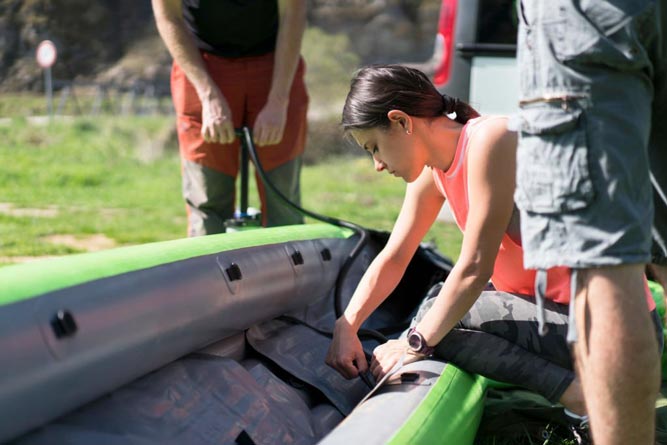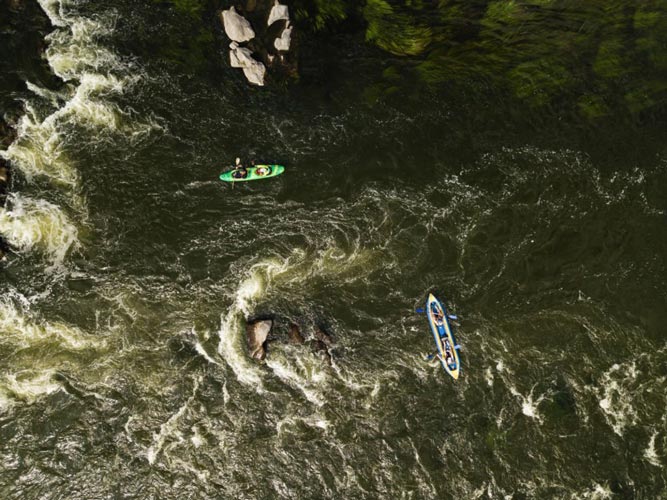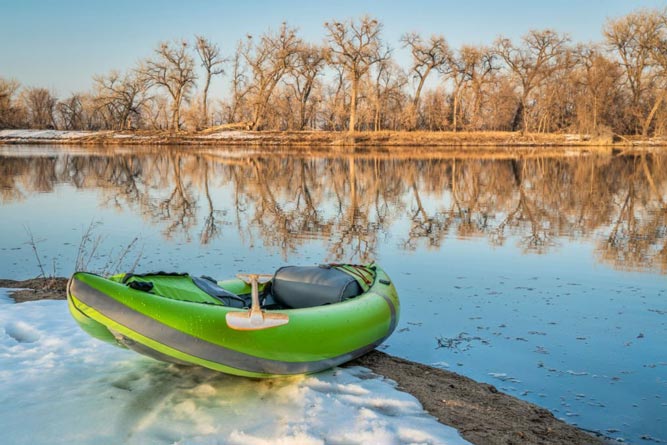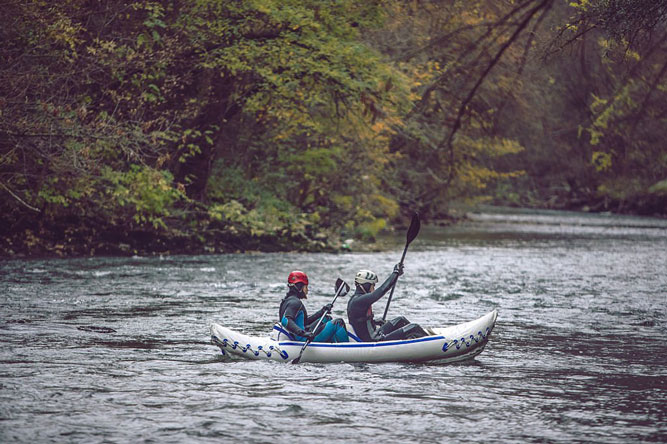So many people are still afraid of the inflatable kayak because of the idea that it was considered as a pool toy back in the days. We are often oblivious to new experiences, so the concept of inflatable kayaks comes with a lot of negativity, especially from those who use rigid kayaks.
Seeking new experiences is the right way to go, and we love inflatable kayaking for recreation and sporting activities.
However, this is a matter of choice whether to use inflatable kayaks or rigid kayaks because both have their pros and cons.
Inflatable Kayak Pros and Cons
Pros of inflatable kayaks

Storage
An inflatable kayak can be deflated for storage, making it fit even in a backpack. It doesn’t occupy much space and is convenient to carry anywhere you want. This feature especially comes in handy for those who live in an apartment/condo and love kayaking.
Cheap
In comparison with other recreational rigid kayaks, inflatable kays are much cheaper. Of course, the prices vary depending on the type of kayak, the materials used, and build quality. You can get your hands on an inflatable kayak with almost half the price of a hard-shell kayak.
However, keep in mind that the price dictates the quality of the kayak. There are inflatable kayaks even fancier than the hard-shell kayaks.
Improved performance
The inflatable kayak you have purchased has a performance range. This might be true that the performance depends greatly on the price, but you can get a decent service out of it.
New and more impressive features are being added to the new product lineup every year. They also come with a wide variety of styles, sizes, and features.
Stability
Most of the branded kayaks are highly stable, extremely resilient, and strong because of their broader base and build quality.
This may be true that people considered inflatable kayaks as pool toys in the past but things have changed a lot since then. Today’s modern designs can take a beating and last a long time.
Lightweight
Inflatable kayaks are super light, making it easy to move from one place to another, but they hold a fair amount of weight. You won’t need help to carry the kayak whether it’s inflated or deflated.
One of the most impressive features of inflatable kayaks is that they can carry a huge load even after being so lightweight.
Portability
Since deflating the kayak is very easy, you’ll have no problems to carry it from one place to another. Just roll it up and put it in the backpack, or the trunk of your car. Most weigh between 30-40 lbs. and you can carry one even on an airplane.
Unsinkable
Like a surfing board, the inflatable kayak has adequate buoyancy to prevent it from sinking. The buoyancy makes it more stable but you have to make sure that all the multiple air chambers are inflated uniformly by using the different kinds of pumps available.
The premium ones are almost impossible to sink. The improved construction and performance will allow the kayak to stay afloat even after having a couple of punctures. This is the reason why inflatable kayaks can carry huge load despite being so lightweight.
Build quality
The rugged construction of thick, durable rubber and quality PVC materials helps the inflatable kayaks to take hit from a dog’s paw, deadheads, sharp tree branches and still be able to float.
You won’t need to worry about punctures anymore since most high-quality modern-day kayaks are almost puncture proof.
However, the better build quality and durability you want, the more you’ll need to spend.
Versatility
Since inflatable kayaks come in many shapes and sizes, there is something for everyone and you can get an inflatable kayak for any type of water you wish to explore.
They are virtually puncture resistant and can help you do fishing, touring, sea kayaking, and more.
Unless you want to tackle class III+ rapids, entering races, or any other type of peddling that requires specialized kayaks, you will do just fine with an inflatable kayak. Their versatility is one of the things that make people interested in them.
Easily repairable
The materials used in inflatable kayaks make them extremely reliable. You don’t have to get worked up about scratching your boat’s composite hull. Even if you do manage to puncture your kayak, it’s easy to repair and you can go back in the water just after a couple of minutes.
Fun to use
No matter what kind of water you want to go kayaking, an inflatable kayak can support all of your kayaking needs. Almost anyone can inflate/deflate and control an inflatable kayak and have fun doing it.
Inflatable kayaks are safe and stable. That’s why they are a great fit for families, dogs, and fishing. They take the most hassles out of kayaking for a fun and smooth experience.
Cons of inflatable kayaks

Long preparation time
A hard-shell kayak comes compared. You just need to place it into the water. On the other hand, an inflatable kayak needs inflation. it can take time, depending on the pump you use.
For instance, an electric pump takes less than a minute while a hand or foot pump can take 7-10 minutes, depending on the kayak’s size. Not everybody likes to wait.
Swiftness
The inflatable boat a bit slower than the rigid kayak in the water. Which can set many people off. The main reason behind this is the weight. Heavy boats tend to stay still in strong wind and waves whereas an inflatable kayak can turn over easily.
Those who are looking for speed and control in rough waters are better suited for hard-shell kayaks. However, the higher-end of inflatable kayaks are really catching up.
Width
The narrower the base, the fast a kayak can maneuver on the water. On the other hand, the wider the base, the more stable the kayak becomes.
There are many people who like kayaking as an extreme sport. They want speed, control, and reliability in their kayaks.
However, I know there are a lot of people who do kayaking just for fans. We don’t need much speed. We want stability instead. An inflatable kayak is the best option for people like that.
Control
Unlike the hard shell ones, the inflatable kayaks are a bit harder to control, especially in the rough weather. They face more resistance from wind and waves, making them harder to control.
Inflatable kayaks usually float on the water instead of in the water. The wider base gives them stability but the cheap ones lack control. The high-end ones can give hard shell kayaks a run for their money.
Drying time
The materials used in an inflatable kayak are waterproof. That’s why if water gets trapped between them, especially when you fold them without properly drying, the water will get trapped and can create an unpleasant odor.
The kayak needs to be fully dried before unfolding and storing which will cost you some time.
Things to Consider When You Buy an Inflatable Kayak

Portability
The lighter your kayak is, the easier it will be to carry around. If you travel frequently by foot and want to take your kayak with you, look for one that can fit inside a large backpack/duffle bag along with the accessories.
There are also dedicated travel options like a breakdown dolly, which can make your transportation much easier. Get one if possible.
Valves
Valves are the thing that controls the inflation and deflation of your kayak. Valves need to be stronger and protected to keep the kayak floating.
There are a number of valves available in different kinds of inflatable kayaks. Choose the one that best suits your needs.
Size
Depending on whether you want to ride solo or with a partner, there are a variety of inflatable kayaks available in the market. Tandem kayaks can hold multiple peddlers and solo kayaks carry a single peddler at a time.
Solo kayaks are great for sports, fishing, and cruising around. On the other hand, Tandem kayaks can support multiple people and are great for family/friends outing and sports.
Load capacity
Kayaks come in different designs, and each design can support weights/loads up to a particular limit. Whitewater kayaks are usually shorter and can carry less load. Figure out how much you want to carry in your kayak and get one that can support the weight effortlessly.
Don’t forget, weight of all of the gears and passengers are included into the load capacity of a kayak.
Materials Used
Many companies in the world produce kayaks using different materials. The quality of the material varies, and some can better withstand harsh conditions than others.
PVC
It is one of the most commonly used materials for an inflatable kayak. PVC stands for polyvinyl chloride and is very tear-proof. However, PVC is sensitive to UV rays coming from the sun.
Nitrylon
This material is known for its toughness. This extremely strong material is used to build high-quality and durable kayaks. Nitrylon is a bit heavier than other materials.
Pennel Orca
Pennel Orca is a synthetic rubber that is used as an exterior coating of the kayak. The material is extremely tough, durable, and abrasion-resistant.
Hypalon
Hypalon is stronger and more durable than PVC. The material is also lighter and more expensive. High-end kayaks are made from this.
Composite
Composite is the mixture all the materials mentioned above. Manufacturers mix up the materials to make your inflatable kayak tough, durable, and lightweight.
Weight
If weight is one of your concerns, we suggest you go for the inflatable kayaks. If you are willing to compromise weight for better speed and control, go for the hard-shell kayaks. Inflatable kayaks are a good option for solo paddlers and hard-shell kayaks are good for groups.
Water type
Kayaking can be done in almost any type of water. No matter what kind of kayaking you enjoy the most, there are kayaks designed for that particular kind of kayaking.
That’s why we recommend you take the water type into consideration. That way, it will be easier to find the perfect vessel for your next adventure.
Inflatable Kayak Safety Tips
When you decide to go kayaking, it goes without saying that you need to be on your guard. Accidents usually occur when we least expect them. You need to be aware of the protection guidelines before you go kayaking. Here are some tips that can help you
- Check your kayak thoroughly before you hit the road. Pay attention if there is any leakage. If you find some, tend them as good as you can. Leakage can cause problems once you are in the water.
- Check out the weather report and prepare yourself accordingly. Being too hot/cold/wet can ruin your experience
- Avoid any obstacles in your path. You never know which of them has a bunch of submerged sharp objects that can dig a hole through your kayak.
- Always wear a lifejacket, no matter how well you can swim. This is non-negotiable.
- Try to keep your kayak parallel to the wind flow and the waves. A perpendicular kayak is much easy to get flipped over by the natural forces
- If your kayak gets flipped over, try to float on your back facing feet first with your toes up so that no submerged obstacles can cause any problems.
FAQs
1. How stable is an inflatable kayak?
Ans: Compared to hard-shell kayaks, inflatable kayaks are extremely stable. Some of them can’t be flipped over on calm water even if you try to flip them. The wider base gives inflatable kayaks more stability in exchange of speed.
2. Where can I get replacement parts?
Ans: You can get replacement parts from the manufacturer or where you purchased your kayak. However, online stores also sell these replacement parts. If you live near a lake or a coastal area, you can also visit your local stores.
3. Can inflatable kayaks go over rocks?
Ans: Yes, of course. Modern inflatable kayaks come with multi-layer construction that is specially designed to provide optimal puncture and abrasion resistance. They can be tough enough to handle anything from fishing hooks to sharp rocks to provide you safety over the water.








Leave a Comment